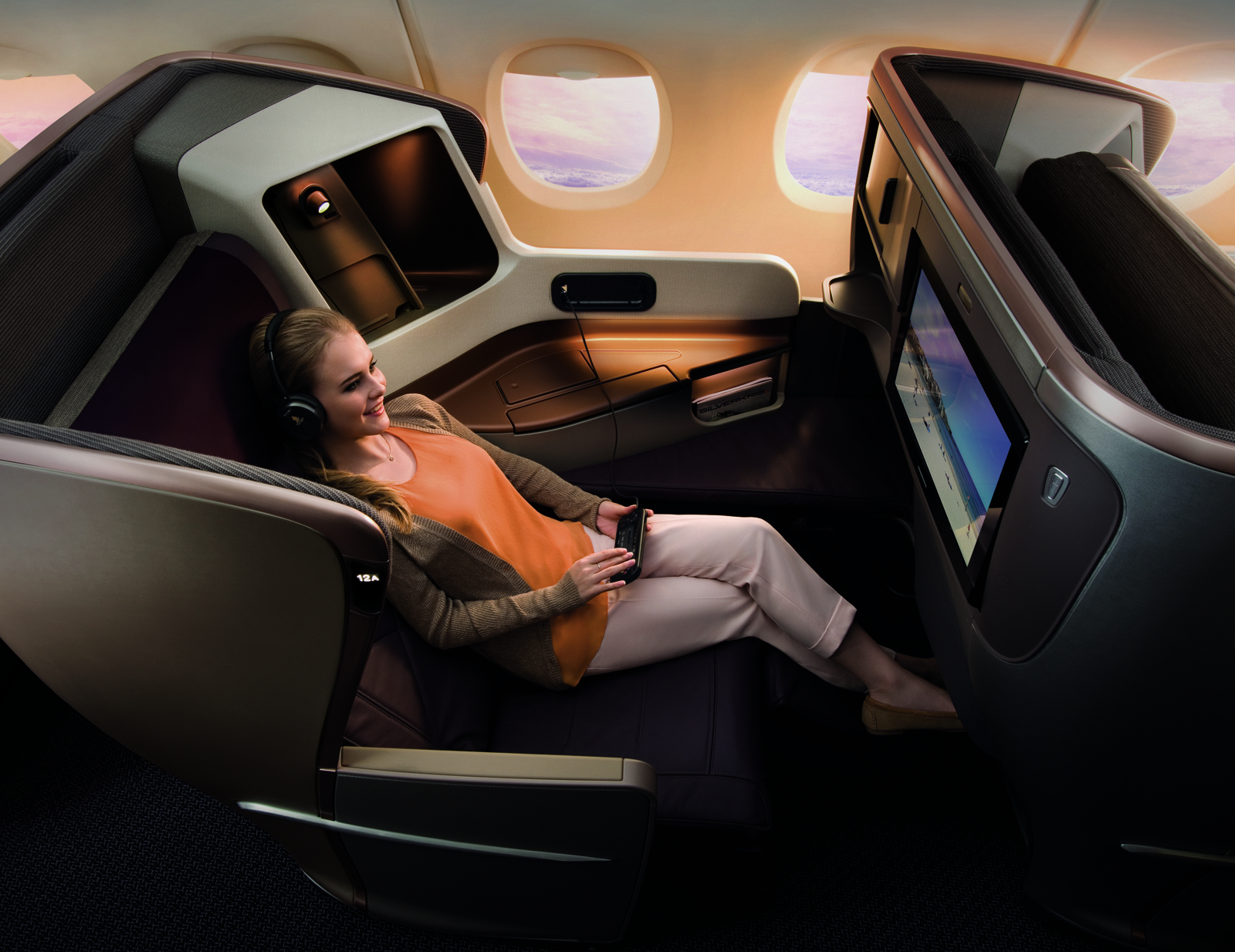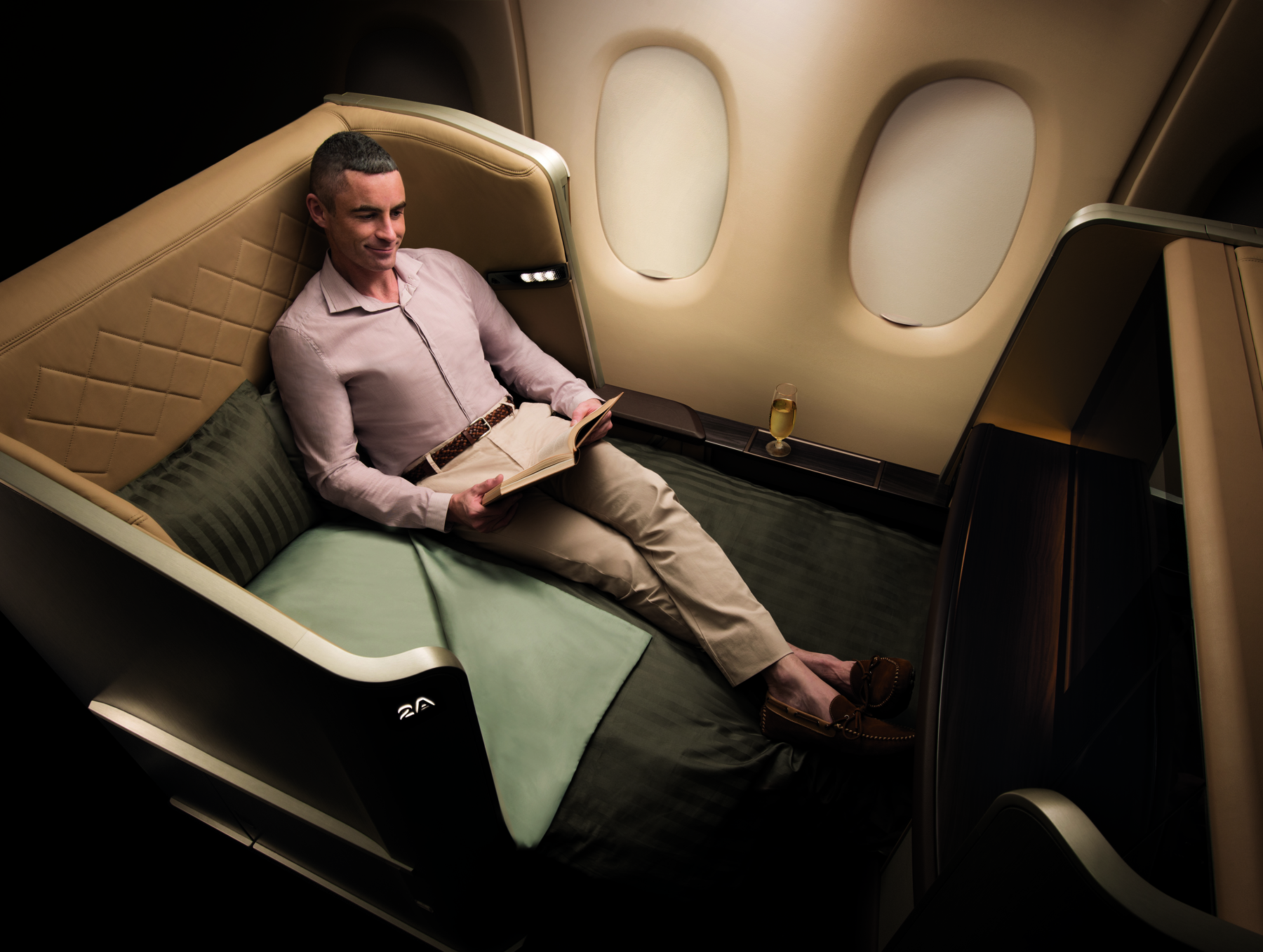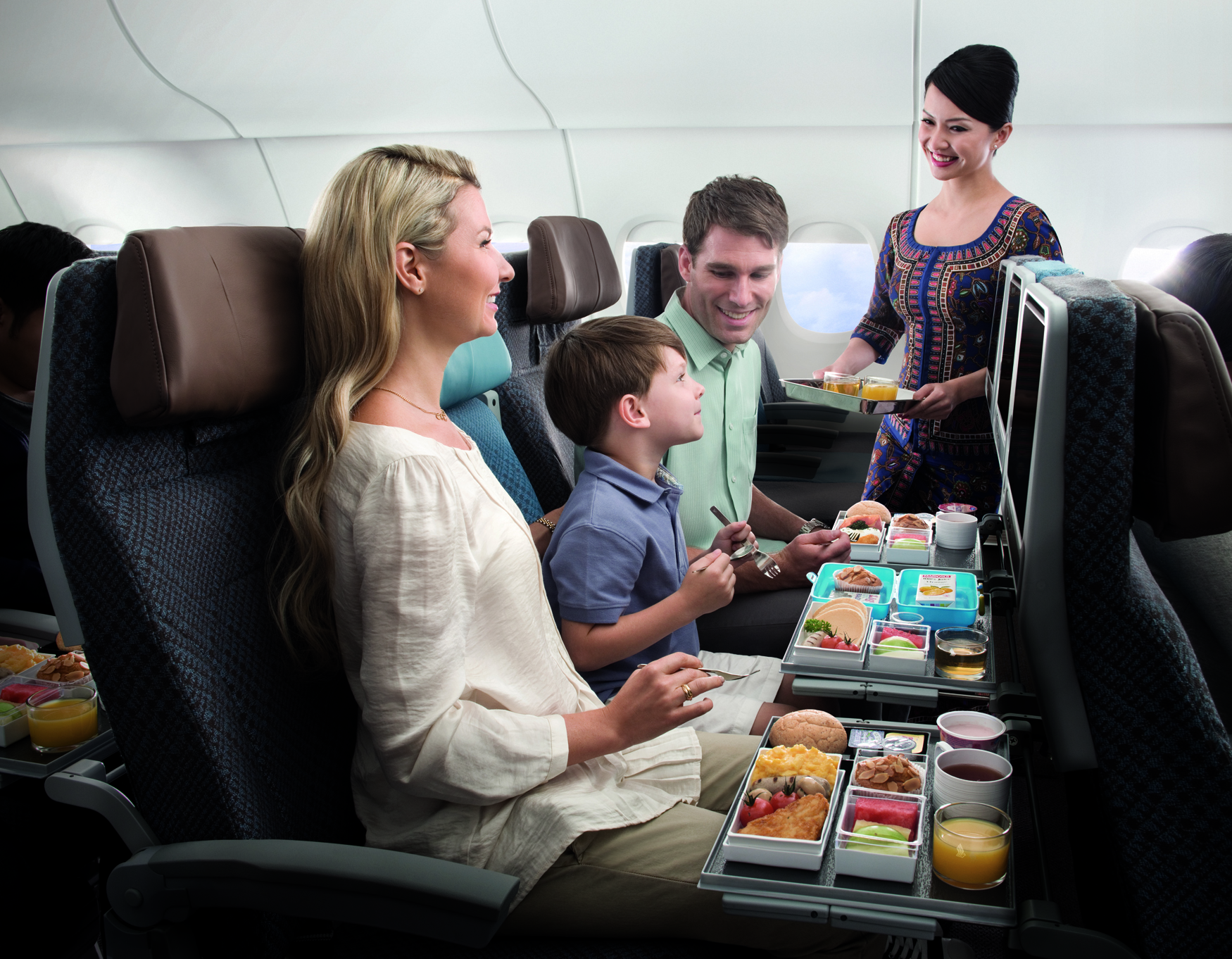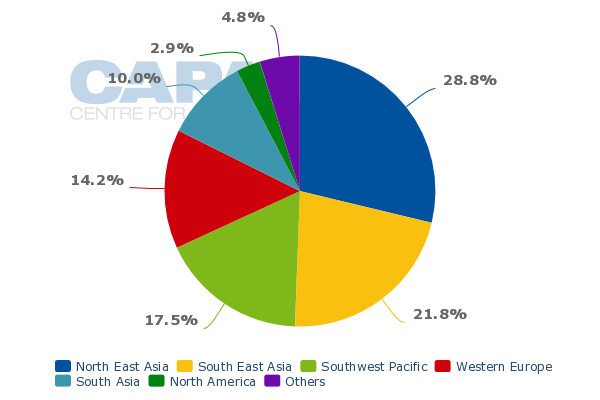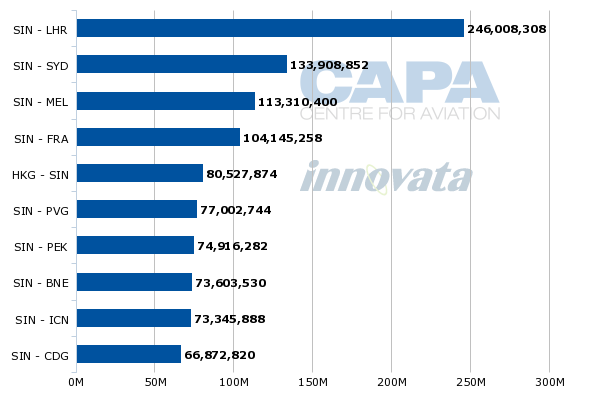Singapore Airlines new cabin products represent baby steps but are important to premium strategy
Singapore Airlines (SIA) has taken another step in reinforcing its position as a leading premium carrier with the launch of a new generation of long-haul cabin products, which will debut in Sep-2013 on new 777-300ERs. By investing in yet another new round of cabins and a recently beefed up widebody aircraft order book, SIA remains fully committed to the long-haul and premium markets while also increasing its focus on the faster-growing regional and budget sectors.
The new cabin products unveiled on 9-Jul-2013 do not match the game changing developments of SIA's last generation of long-haul premium products, which were introduced nearly seven years ago and established a new benchmark in the industry. But the opportunities for establishing another new benchmark are limited given where the industry is in the product development cycle.
SIA only needs to tweak its product to remain a leading premium carrier. But the reality is SIA now shares the space at the top with more carriers than ever before.
Competition at the top intensifies for SIA
Gulf carriers have particularly been aggressive at developing new premium products aimed at matching SIA and are now planning a new round of cabin upgrades. SIA's response is increasingly not with new hardware but to emphasise to corporate customers the value of its network and the "soft" portion of its premium offering, including lounges and its award-winning cabin service which it is trying to maintain by continuing to invest heavily in training and recruitment.
Gulf carriers, however, are expanding their networks more rapidly and are also investing in lounges and service improvements. The increased competition has led to a reduction on premium yields in some markets. SIA has responded partially by focusing more on regional rather than intercontinental connections as Gulf carriers focus on the latter. Nearly all of SIA Group's growth in recent years has been within Asia-Pacific, including Australia, although this also has become a more competitive market with rapid expansion from other Asian carriers in both the full-service and low-cost sectors.
In the nearly seven years since SIA introduced its current breakthrough generation of long-haul premium products, several European and North American carriers have also significantly narrowed the gap. This has increased competition for SIA on its long-haul routes at a time demand for premium services to and from Europe and North America has flattened.
Competition all around continues to intensify. While SIA's new cabin products represent an important strategic step it will not make a significant difference in its fight to maintain and grow its lucrative slice of the premium market.
SIA new cabin products represent an evolution rather than a new benchmark
SIA's new generation of cabin products are essentially an evolution to the business and first class seats which were introduced in Dec-2006, when SIA's first 777-300ER was placed into service. These seats are now featured on SIA's existing fleet of 19 777-300ERs. The business class seats are also included in SIA's 19 A380s but in first class these aircraft are exclusively configured with the carrier's super luxurious Suites product, which was developed at the same time but were introduced one year later due to A380 delivery delays.
In terms of physical dimensions the new business and first class seats represent just a small adjustment compared to the current product on the 777-300ER. The length of seats in flat bed configuration has been extended by only 2in - to 78in in business and 82in first. The layout will remain 1-2-1 in both premium cabins with eight first class and 42 business class seats.
While the width of the first class seat remains 35in, the width of the business class seat has been reduced by 2in to 28in, in a move to free up space for more storage, easier to access control switches and power sockets and other new features. Even with the reduction SIA will still have the widest business class seat in the industry. Passenger feedback with the current long-haul business class seat has been that it is too wide and awkward when not sleeping. The new seat has two additional seating positions to improve comfort when lounging.
SIA's new-generation business class product
In first class the focus has been on changing the overall cabin rather than the seat. Privacy, an important component of the travel experience for first class passengers, has particularly been improved. The extension of the seat shell means passengers will no longer be able to see each other as is the case in SIA's current first class cabin on the 777-300ER.
SIA's new-generation first class product
The economy cabin in SIA's new 777-300ERs will remain 228 seats in 3-3-3 configuration. A 32in seat pitch has been maintained but SIA says an additional 1in of legroom has been achieved by switching to a more efficient and ergonomic design. In response to customer feedback, a softer cushion is also being introduced in economy that is designed to provide improved support and comfort.
SIA's new-generation economy class product
SIA is also introducing with its forthcoming batch of new 777-300ERs a new generation of its in-flight entertainment system KrisWorld. LCD screens have increased in size across all classes, from 23in to 24in in first; 15.4in to 18in in business; and 10.6 to 11.1in in economy. For the first time touch screen handsets will be used. SIA's current long-haul fleet have touch screen monitors but conventional handsets in all classes.
A350 delays force SIA to debut new product on 777-300ER, starting with London
The new generation of business and economy products were initially envisioned to debut on the A350. But, similar to the circumstances of seven years ago, the 777-300ER will once again be the initial platform as a result of aircraft programme delays at Airbus.
Design work on the new business class cabin was already well underway at James Park Associates, which also designed the current generation business class seats, when the decision was made about two years ago to have the seat debut on 777-300ERs instead of the A350. The firm designing the new first class product, BMW Group DesignworksUSA, had significantly less time because the new generation cabin products was initially not slated to include first class as the A350 is intended to be a two-cabin aircraft. While the work done in designing an improved business class cabin was ground-up, with SIA and James Park ultimately deciding to keep the same lay-out and a similar seat while introducing several improvements, there was not sufficient time to design a new first class cabin from scratch.
SIA ordered the eight additional 777-300ERs which are slated to now get the new generation cabin products in 2011. The first of these aircraft will be placed into service in Sep-2013 and operate on the Singapore-London route. SIA currently operates four daily flights to London, including three A380 frequencies and one daily 777-300ER frequency.
SIA has not yet announced subsequent routes for the new product. It is slated to receive two additional 777-300ERs in the current fiscal year, which ends on 31-Mar-2014 (FY2014), and the final five aircraft in FY2015.
SIA has so far only committed to introducing the new cabin products on the new batch of eight additional 777-300ERs. As a result, SIA has invested only USD150 million in the programme thus far. With the last generation of new products, SIA's commitment from the beginning was much more substantial.
SIA says it plans to extend the programme to A350s but has not yet committed on dates or the number of A350s which will receive the new generation of cabin products. SIA has 70 A350-900s but a large portion of this fleet and all 30 787-10s that it recently ordered are intended for medium-haul routes. This will likely limit the number of aircraft that will get the new generation cabin product to fewer than the 48 aircraft that have been outfitted or are currently in the process of being outfitted with the generation introduced in 2006.
SIA elects not to put the new product on its flagship, the A380
SIA says it is also considering retrofitting its current fleet with the new product but again no decision has been made. Significantly, SIA has not yet decided to retrofit its existing A380s or include the new product on the five additional A380s it ordered in 2012 for delivery from 2017. SIA executive vice president commercial Mak Swee Wah said at the 9-Jul-2013 media briefing unveiling the new generation product that the product on the A380 "is still a very good product" and pointed out that it set the industry benchmark for premium seats.
SIA's decision to stick with the current generation business class seat on its flagship A380 illustrates the fact the new product is a relatively small evolution rather than a step change. If SIA and James Park were able to raise the bar once again it would move to introduce the new business class seat across its long-haul fleet in an attempt to leverage a competitive advantage. But the technology is not at the point to support a new benchmark and as a result the benefits of retrofitting the A380 fleet, which is less than six years old, are not great enough to merit the huge expense of retrofitting the super jumbo.
SIA also has already started work on its next next-generation of long-haul cabin products. This subsequent generation could potentially debut on the five additional A380s and be installed on a retrofit basis on the 19 existing A380s. Investing in an A380 refresh starting about 2017 would be logical because at that point the existing 19 aircraft would be between five and 11 years old. It would also be timed when the additional five A380s are delivered and when it is more likely there is an opportunity in the product development cycle to come up with a new benchmark.
Meanwhile, SIA will closely monitor customer feedback on its forthcoming batch of eight 777-300ERs to determine if it should incorporate the new business class seat as part of its next next-generation or go with something more significantly different. First class will be a separate review as SIA is at least for now committed to offering a Suite product on its A380 and a more standard yet enhanced first class product on its 777-300ERs. Mr Mak says SIA is committed to continue offering a first class on its "key" routes as it has a loyal first class clientele that, while small, is an important segment of its business.
SIA rules out premium economy - again
The 2017 timeframe could also provide a window to introduce a new first class to replace the Suites product, which has not been reviewed as part of the current new generation product. A380 economy seats could also be replaced at this juncture, likely with an evolution of the new economy seat. In addition, SIA could re-look at a possible premium economy product when it does move on retrofitting its A380 fleet.
SIA studied premium economy as part of the exercise in developing the new generation long-haul cabin products. But as it has done in previous cabin product reviews SIA decided again not to follow several competitors, including most recently Cathay Pacific, in introducing a premium economy cabin. Mr Mak says the reviews of premium economy will continue: "It's something we look at all the time."
It is logical for London to be the launch route for SIA's new generation of cabin products as it is SIA's biggest long-haul route. But SIA will not be able to offer a standard business class product on the route as the A380 that is used for three of SIA's four London Heathrow frequencies will continue to have the current generation product.
The decision not to introduce the new generation business class product across its long-haul fleet risks limiting the potential positive impact given that some of SIA's long-haul markets are served with a mix of 777-300s and A380s, including London and Frankfurt. Other routes that are served only with 777-300ERs may also see a non-standard product offering given the small size of the sub-fleet that will receive the new product.
The fact SIA does not seem concerned about these kinds of mismatches further highlights the fact that the new generation product is only marginally better than the current generation. Unlike the last generation of new premium cabins, which came with higher fares for those flights offering the new product, SIA is not planning to charge a premium for those flights with the new generation product.
New generation product expected to eventually be introduced on 777-200ER replacements
While SIA says it plans to introduce the new products on the A350 "in the years ahead," the products may end up only on the small portion of the A350-900 fleet, including the A350s which are slated to replace its 10 777-200ERs. SIA now primarily uses its 777-200ERs to serve seven thinner long-haul routes: Singapore to Amsterdam, Copenhagen, Istanbul, Rome, Auckland, Christchurch and Johannesburg with continuing service to Cape Town. These are the only routes in SIA's long-haul network which are not served with A380s or 777-300ERs as the markets are seen as too small to support the larger three-class widebodies. SIA also uses the 777-200ER on some of its flights on Singapore-Mumbai and Singapore-Sydney, which are considered medium-haul routes.
SIA only committed to retrofitting its 777-200ER fleet in Dec-2012 and is currently in the process of installing the current generation of business class seats on its 10 777-200ERs, matching the product on the current 777-300ERs and A380s. The retrofit project will be completed by the end of the fiscal year ending 31-Mar-2014 (FY2014) at a cost of SGD95 million (USD74 million).
The fact SIA did not wait a few months in retrofitting its 777-200ERs for the new generation of business class seats to become available further highlights the relatively small evolution in its new generation. SIA was also eager to get going with the retrofit project as it was long overdue and particularly necessary after SIA phased out its 747-400 fleet in early 2012. The 747-400 and 777-200ER had an old generation business class seat. The seat was still lie-flat but narrow and in the 777-200ER it was in 2x2x2 configuration rather than the much preferred 1x2x1 configuration in the 777-300ER.
The start of the 777-200ER retrofit programme was set back by the problems at Japanese seat manufacturer Koito. The issues at Koito forced SIA to prioritise and focus on new 777-300ERs and A380s to mitigate costly delays in placing into service new aircraft. The problems have now been resolved as Jamco has taken over from Koito. Jamco also has been again selected to supply the new generation of business and first class seats.
SIA's 777-200ERs do not have a first class cabin and the carrier is not planning to introduce first class once its 777-200ER routes are upgraded to more efficient A350-900s. SIA is aiming to replace these aircraft with A350-900s featuring a similar configuration and total number of seats as the reconfigured 777-200ERs, which have 26 business class and 245 economy class seats.
Large portion of A350 fleet will likely be used for medium-haul services
SIA has not said if its first batch of A350-900s will be allocated to replace 777-200ERs on thin long-haul routes but this seems unlikely given the recent investment in retrofitting the 777-200ERs. SIA however, is also looking at using a portion of its A350-900 to replace 777-300ERs on select routes such as Singapore-Barcelona-Sao Paulo.
The 777-300ER along with the A380 will remain the backbone of SIA's long-haul operation and will not be replaced with A350-900s as SIA is instead starting to ponder the 777X and A350-1000 as long-term replacement candidates for the 777-300ER. But there will be opportunities to use the smaller A350-900 to introduce more frequency and improve efficiency on some relatively thin long-haul routes which are now served with 777-300ERs. There will also be an opportunity to use the A350-900 to open up new long-haul routes which are not presently viable with SIA's current fleet.
But the majority of SIA'S A350-900s will likely be used on medium and short-haul routes. SIA's medium-haul fleet now consist of 49 aircraft, including 20 777-200s, seven 777-300s and 22 leased A330-300s. Another 12 leased A330-300s are to be delivered by the end of 2015. (All the A330s are being leased, which is unusual for SIA, as the carrier is using the aircraft as a bridge until A350s and 787s are delivered.)
There will be significant opportunities to grow the medium-haul fleet as SIA continues to focus capacity on its medium-haul network, which includes flights within Asia as well as parts of Australia and the Middle East. SIA has been rapidly expanding regionally by accelerating growth at regional subsidiary SilkAir, which plans to more than double the size of its fleet over the next several years, as well as more regional flying under the SIA brand.
Australia particularly has been a big growth market for SIA over the last year, where it has increased capacity by 37% year-over-year. But SIA also has been adding flights in the short-haul markets of Indonesia and Myanmar (in some cases up-gauging flights previously operated by SilkAir) and is adding capacity to India. New and increased partnerships, including a recently increased equity stake in Virgin Australia, is also an important component of SIA's new more Asia-focused strategy.
See related reports:
- Singapore Airlines needs more partnerships to complete new long-term strategy
- Singapore Airlines cements its partnership with Virgin Australia, joining ANZ and challenging Etihad
- Singapore Airlines looks to ride out the storm as profits continue to slide
- Singapore Airlines Group aims to improve its long-term outlook following its biggest ever strategy shift
The Asia-Pacific region now accounts for 78% of SIA's seat capacity (excludes SilkAir).
Singapore Airlines capacity share (% of seats) by region: 8-Jul-2013 to 14-Jul-2013
Even on an ASK basis, Asia-Pacific accounts for 59% of the carrier's capacity and seven of its top 10 routes. Only three of SIA's 12 European routes are among its 10 largest based on ASKs, including Singapore-London which is in the number one position.
Singapore Airlines top 10 routes ranked by ASKs: 8-Jul-2013 to 14-Jul-2013
SIA in recent years has not been pursuing significant growth in Europe or North America. Its long-haul network is not expected to see growth in the short to medium-term although growth could resume in the medium to long-term if market conditions in Europe and North America improve. In the meantime, SIA's medium-haul fleet could easily grow to over 80 aircraft by the time the last batch of A350-900s and 787-10s are delivered. That would potentially leave only about 20 A350s for long-haul routes although SIA has options on more A350s that it could exercise if conditions are favourable.
SIA fleet: as of 10-Jul-2013
SIA's first batch of A350s are due to be delivered from 2015. These are aircraft from the 20-aircraft order placed in 2006. SIA has ordered another 50 787s in recent months, completing deals for 20 in Jan-2013 and 30 in Jun-2013, for delivery from FY2017. (It also firmed up in Jun-2013 an order for 30 787-10s for delivery from FY2019.)
SIA and SilkAir plan cabin product improvements for regional fleets
While the new generation economy class product could be used across both the medium and long-haul fleets, SIA is now reviewing its medium-haul premium product. SIA in 2009 introduced a new regional business class product, featuring angled business class seats, for medium-haul routes. This product is now featured in the carrier's A330 fleet and on some retrofitted 777-200/300s.
SIA does not plan to introduce its long-haul product across medium-haul routes but will likely again improve its medium-haul product when it introduces A350-900s in medium-haul configuration and its 787-10s, all of which will be configured for medium-haul flights. SIA continues to be under pressure to improve its medium-haul product as it competes on some medium-haul routes against carriers offering a full lie-flat product. Several of SIA's medium-haul flights are overnight, including from South Asia, the Middle East, Australia and North Asia. While SIA rotates its 777-300ERs, A380s and recently refitted 777-200ERs on some of these flights, a majority are still served with 777s and A330s in medium-haul configuration with the regional product introduced in 2009 (and in some cases on non-retrofitted 777-200s, which still have a more outdated regional product).
While SIA looks at making the necessary adjustments in its medium-haul offering, SilkAir is also expected to introduce new cabin products in parallel to the introduction of 737s. In 2012 the regional carrier placed orders for 23 737-800s and 31 737 MAX 8s, which will be used to replace its current fleet of 23 A320 family aircraft as well as for significant growth. SilkAir's first 737-800 is being delivered later, giving it an opportunity to introduce new business and economy products.
See related report: Singapore Airlines regional unit SilkAir poised for rapid growth after quietly emerging as SIA's gem
SilkAir is not expected to introduce an angled (or fully) lie-flat seat even though the carrier operates overnight flights on some of its China and South Asia routes. But SilkAir is under increasing pressure from SIA's corporate customers to improve its business class product. Economy class may also be improved, including the introduction of an in-flight entertainment system. SilkAir is currently behind other Asian full-service regional carriers in terms of its product offering in both cabins. As SilkAir continues to expand and offer connections to SIA's long-haul network, an upgrade is necessary.
Mr Mak during the unveiling of the new SIA product hinted at a SilkAir announcement, saying the carrier has its own plans to upgrade its cabin product but the product will be different as it focuses on a different segment of the market. While SilkAir is carrying an increasing number of business passengers, including premium passengers connecting from SIA, it remains primarily a leisure carrier.
Premium sector remains a focus for SIA even as it diversifies with multi-brand strategy
Regional growth at the top and bottom ends of the market is an important component of the SIA Group's new strategy. But SIA is not about to lose focus on its long-haul premium roots.
The group has the cash to invest in continuing to improve its long-haul premium product while also investing in ambitious expansion at full-service regional subsidiary SilkAir and medium-haul low-cost subsidiary Scoot and increasing its involvement in short-haul low-cost affiliate Tigerair. SIA is also in position to quickly again pursue long-haul expansion once market conditions improve as SIA has a lot of flexibility in its 100-plus widebody aircraft order book.
The new long-haul cabin products are not by any means game changing. They are just a small step as SIA continues to respond to intensifying competition in the premium end of the market.
